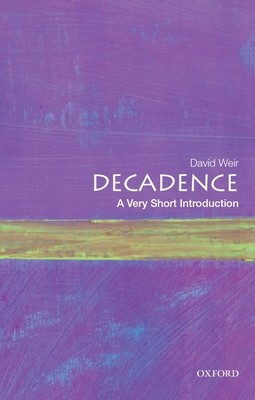
- We will send in 10–14 business days.
- Author: David Weir
- Publisher: Oxford University Press, USA
- Year: 2021
- Pages: 160
- ISBN-10: 0190610220
- ISBN-13: 9780190610227
- Format: 11.2 x 16.8 x 1.3 cm, minkšti viršeliai
- Language: English
- SAVE -10% with code: EXTRA
Reviews
Description
The history of decadent culture runs from ancient Rome to nineteenth-century Paris, Victorian London, fin de siècle Vienna, Weimar Berlin, and beyond. The decline of Rome provides the pattern for both aesthetic and social decadence, a pattern that artists and writers in the nineteenth century
imitated, emulated, parodied, and otherwise manipulated for aesthetic gain. What begins as the moral condemnation of modernity in mid-nineteenth century France on the part of decadent authors such as Charles Baudelaire ends up as the perverse celebration of the pessimism that accompanies imperial
decline. This delight in decline informs the rich canon of decadence that runs from Joris-Karl Huysmans's à Rebours to Oscar Wilde's The Picture of Dorian Gray, Aubrey Beardsley's drawings, Gustav Klimt's paintings, and numerous other works.
pleasurable or gratuitously cruel. Such contrariness between aesthetic and social decadence led some of its practitioners to substitute art for life and to stress the importance of taste over morality, a maneuver with far-reaching consequences, especially as decadence enters the realm of popular
culture today. ABOUT THE SERIES: The Very Short Introductions series from Oxford University Press contains hundreds of titles in almost every subject area. These pocket-sized books are the perfect way to get ahead in a new subject quickly. Our expert authors combine facts, analysis, perspective, new ideas, and
enthusiasm to make interesting and challenging topics highly readable.
- Author: David Weir
- Publisher: Oxford University Press, USA
- Year: 2021
- Pages: 160
- ISBN-10: 0190610220
- ISBN-13: 9780190610227
- Format: 11.2 x 16.8 x 1.3 cm, minkšti viršeliai
- Language: English English
The history of decadent culture runs from ancient Rome to nineteenth-century Paris, Victorian London, fin de siècle Vienna, Weimar Berlin, and beyond. The decline of Rome provides the pattern for both aesthetic and social decadence, a pattern that artists and writers in the nineteenth century
imitated, emulated, parodied, and otherwise manipulated for aesthetic gain. What begins as the moral condemnation of modernity in mid-nineteenth century France on the part of decadent authors such as Charles Baudelaire ends up as the perverse celebration of the pessimism that accompanies imperial
decline. This delight in decline informs the rich canon of decadence that runs from Joris-Karl Huysmans's à Rebours to Oscar Wilde's The Picture of Dorian Gray, Aubrey Beardsley's drawings, Gustav Klimt's paintings, and numerous other works.
pleasurable or gratuitously cruel. Such contrariness between aesthetic and social decadence led some of its practitioners to substitute art for life and to stress the importance of taste over morality, a maneuver with far-reaching consequences, especially as decadence enters the realm of popular
culture today. ABOUT THE SERIES: The Very Short Introductions series from Oxford University Press contains hundreds of titles in almost every subject area. These pocket-sized books are the perfect way to get ahead in a new subject quickly. Our expert authors combine facts, analysis, perspective, new ideas, and
enthusiasm to make interesting and challenging topics highly readable.


Reviews